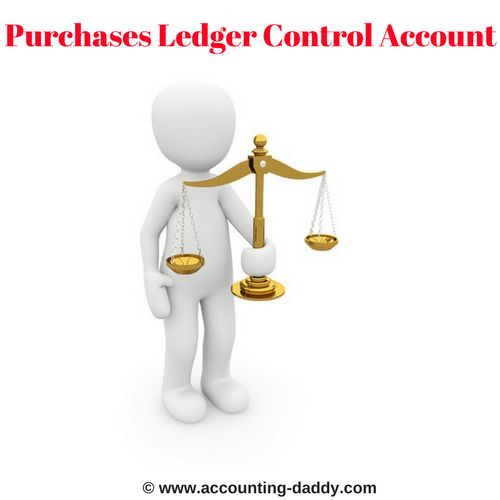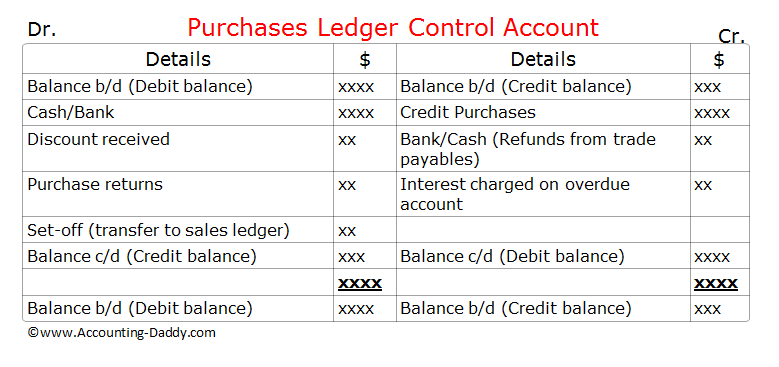|
|
Purchases Ledger Control Account.
Purchases Ledger Control Account is a summary account which checks the arithmetical accuracy of the Purchases Ledger. It enables us to see at a glance whether the general ledger balance for the purchases ledger agrees with the total of all the individual trade payable accounts held within the purchases ledger.
This Control Account typically looks like a "T-Account" or a replica of an Individual Trade Payable ( Creditor) account, but instead of containing transactions related to one trade payable (creditor) it contains transactions related to all the trade payables (all the creditors) in the business. As this control account contains the summarized information of all the trade payables accounts in the purchases ledger, it is also called as "Total Trade Payables Account"("Total Creditors Account").
Check out the format of this control account below and try to perceive the similarities with individual trade payables account (creditors account).
Format:
Purchases ledger control account is generally prepared at the end of the financial year or "whenever" it is required to check the arithmetical accuracy of the individual trade payable accounts.
As we discussed earlier, this control account is prepared as an independent check on the arithmetical accuracy of the purchases ledger (creditors ledger). So, we should not obtain the information required to prepare this control account from the purchases ledger (creditors ledger), instead all the information required should be obtained from books of original entry or prime entry.
How to check the arithmetical accuracy of the purchases ledger:
Once the control account is prepared using the above format with the information obtained from various books of prime entry/original entry, the total of balances on the individual trade paybales accounts (creditors accounts) in the purchases ledger should match with the closing balances on the Purchases Ledger Control account.
If the closing balances of purchases ledger control account and the total of balances on the individual trade payables accounts in the purchases ledger agrees, we can presume that there are no errors in the purchases ledger or fraud occurred in the business. If the balances differ, it indicate that there are errors in the individual trade payables accounts in the purchases ledger or in the control account. So to locate these errors, accountants need to check each and every trade payables account in the purchases ledger carefully until the error is found or the fraud is detected.
Source of information for Purchases Ledger Control Account:
The following table provides the details of source of information for the purchases ledger control account items.
|
S.No |
Item |
Source of information |
|
1. |
Opening trade payables (opening creditors) |
Total of Trade payables balances at the end of the previous accounting period. |
|
2. |
Credit Purchases |
Total Credit Purchases from the Purchases Day Book (Purchases Journal). |
|
3. |
Purchase returns (Return outwards) |
Total purchase returns from the Return Outwards Day book (Purchase returns journal). |
|
4. |
Cash paid |
From the cash column on the credit side of the Cash Book. |
|
5. |
Cheques paid |
From the bank column on the credit side of the Cash Book. |
|
6. |
Discount received |
Total of the Discount column on the credit side of the Cash book. |
|
7. |
Refunds from trade payables (creditors) |
From cash/bank column on the debit side of the Cash book. |
|
8. |
Set off (Transfer to sales ledger) |
From the Journal (Proper Journal). |
|
9. |
Interest charged on overdue accounts. |
From the Journal (Proper Journal). |
|
10. |
Closing trade payables (closing creditors) |
Total of Trade payables balances at the end of the current accounting period. |
Items should not be entered in the Purchases Ledger Control Account.
The following items are often seen in the control account questions. As these times are closely related to the "purchases and trade payables", students often confuse and record them in the P L Control Account. But these items should not be recorded in the control accounts. Lets check these items below.
1. Cash Purchases:
Cash purchases are recorded cash book but not in the purchases ledger. So cash purchases should not be entered in the P L Control account which checks the arithmetical accuracy of the purchases ledger.
Reasons for opening and closing debit balances in the P L control account:
Trade payables (creditors) accounts generally shows credit balance in the business books. This balance represents money owed to the trade payables (creditors) by the business. However some times trade payable (creditor) account may show a debit balance. It indicates trade payable owes money to the business. It may happen due to one of the following reasons:
- An error in one of the individual trade payables account.
- Over payment made to the credit supplier (trade payable).
- Advance payment to the trade payable for the goods.
- Accountant forgot to deduct the cash discount before paying the amount to the credit supplier.
- Business returned the goods after making the full payment to the credit supplier but the supplier has not yet refunded the amount.
|
|







New! Comments
Have your say about what you just read! Leave us a comment in the box below.